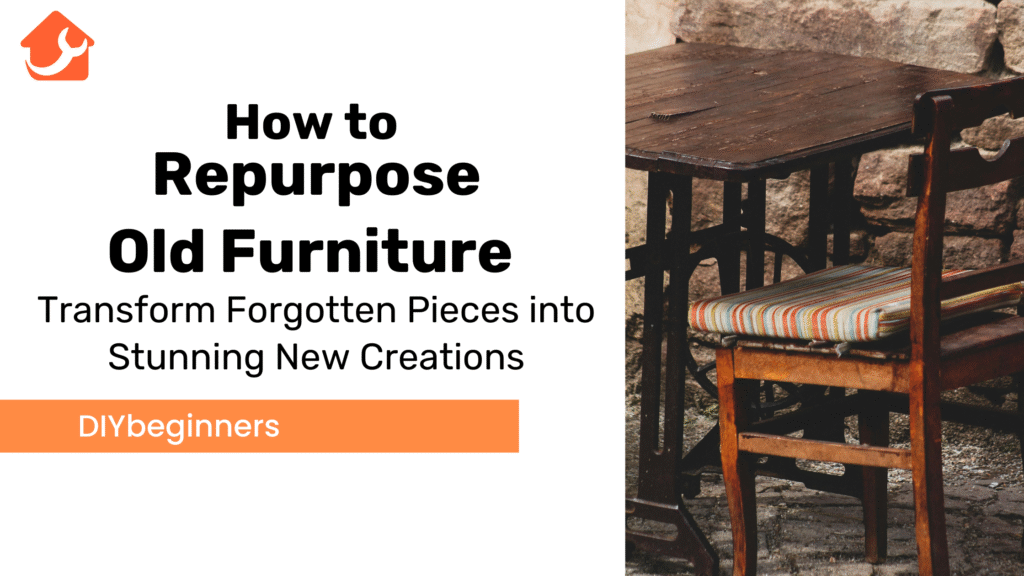
Reusing old furniture is not only good for the environment, but it also helps you create something special to use in your home. This trend is increasing, and both creativity and sustainability are involved in bringing life to items that could have ended up in landfills. Whether you have been DIYing for years or are new to the craft, this year-long guide will take you through all the ways to refresh and revive old furniture.
Why Consider Repurposing Old Furniture?
Pull up a chair (maybe to an old one) before wading into the how-to, and why we should do as much re-usage of older furniture as we can. Upcycling of old furniture has become a popular art as more individuals adopt the idea of living a green life. Older furniture tends to use solid wood construction and top materials that is de,o last, unlike its mass-produced counterparts of today.
By restoring old furniture, not only do you get an economical item, but you also get to have something with personality and one with a past. The upcycling of furniture is advised by many interior designers who compare it to store-bought furniture, which simply cannot give your home the personality that will be apparent. And of course, the pride of having developed something withownl hands.
Upcycling of furniture will enable you to make use of furniture that would have rotted to become landfill. As per the research on environmental studies, the furniture as a household waste accounts for a sizeable extent, whereby millions of tons of furniture end up in the dumps every year. Giving these items a second life will mean that you are making an environmentally conscious decision.
Essential Preparation Steps
1. Assessing Your Piece
Always analyze before embarking on any upcycling task on any furniture piece to tell you what you are dealing with. Ask yourself:
- Could it be seeing their basis is right?
- Do repairs come before cosmetic changes?
- So what is material? Levels of treatment vary because of differences in materials.
- Do you have in mind how you will go about making the transformed work?
Repurposing furniture succeeds when there is proper preparation and planning. Measure and take photos in every direction to be able to see the change.
2. Cleaning and Repairs
Repainting old furniture: Before reusing old furniture, it is always a good habit to deep clean and ready the surface. Hey! Just strip it of everything, put everything in labeled plastic bags, and reassemble it easily later. Wood sections can be cleaned up with a gentle cleaning agent for the finish.
To repair, you need all these basics:
- Adhesive for timber for loose connections
- Wood filler for gaps and fissures
- Sandpaper of different grits
- Clamps for holding parts while the adhesive sets
There has to be safety thought about. Handle sanding or stripping chemicals with it to wear protective gear such as goggles, gloves, and a mask. Perform the task in a ventilated place to prevent the damaging fumes from being inhaled.
Essential Tools and Materials for Furniture Transformation
Repurposing furniture often requires some creativity and vision to see the potential in old pieces. Having the right tools on hand makes the process much smoother.
- Screws (drill, turned Phillips)
- Hammer
- Pliers
- Measuring tape
- Drop Cloths
- Sandpaper 80,120, 220.
- Level
- Brushes, Mixed product brushes, smalls unused.
1. Materials to Have on Hand
Depending on the type of your project, the materials required will have individual variation, but a fair start would include:
- Primer Stain/Paint
- Lack of, or water sealer
- Recent hardware (when it comes to replacement)
- Cleaning supplies
- Wood filler
- Wood glue
The study of old furniture refurbishing begins with the primer techniques, such as sanding and priming. To start, it is much easier to work with water-based paints as compared to oil-based paints. The drying time is shorter, even though they can be cleaned using soap and water.
Creative Repurposing Ideas Old Furniture Enthusiasts Will Love
Looking for repurposing ideas for old furniture pieces? Consider these transformations that completely reimagine a piece’s function:
1. Dresser Transformations
Very old dressers are far too useful:
- Island configuration made up of a kitchen with a butcher block on top
- Sank cutout bank of bathroom vanities
- Entertainment center
- one specific bench storage pull-out upper drawers, put a cushion flat on top)
2. Table Reinventions
Besides the repurposing of old furniture, unique ideas about making use of tables in a new way are:
- The coffee table is an old door.
- A homeowner’s kitchen, en desk dining space.
- Mod to add kitchen table to potting /ctrl bench.
- A drop-leaf table as a wall-mounted space-saving desk
3. Chair Makeovers
Recycling is possible with orphaned furniture or half of a single chair:
- Side entrance bench of two chairs interposed by a board
- Plant stand
- Seat may be removed; shelving may be added.. Bedside table
- Lockers on walls with coin change units offering a place to store clothes you do not want to carry around.
The repurposing ideas that can be implemented by the old furniture enthusiasts are endless;s, one can turn the headboards into benches and transform the dressers into bathroom vanities. There is only your imagination as a limit.
What to Do with Old Furniture: Specialized Transformations
If you’re wondering what to do with old furniture beyond the common transformations, consider these specialized ideas:
1. Outdoor Repurposing
Creative medium upcycling concepts turning out used furniture, and on the other hand, this can include turning a monurateur into a planter, upon turning an approximate door into a table. In painting outdoors, one needs to apply the weatherproof paint, weatherproof sealers. Consider:
- Dresser drawers as garden planters
- Headboard as a garden bench
- Chair as a plant stand
- Wooden ladder as a vertical planter
2. For Children’s Spaces
Repurposed furniture can create magical spaces for kids:
- Dresser into a play kitchen
- Crib into a desk
- Bookcase into a dollhouse
- Old suitcase into a pet bed
Exploring unique ways to repurpose old furniture can lead to one-of-a-kind pieces for your home that serve both practical and aesthetic purposes.
Conclusion:
Using upcycled furniture can be a lot more than a cost-effective DIY idea; instead, it can be a source of creativity, with items that end up having a history and personality. It does not matter whether you are preserving family possessions that have been passed down or salvaging things you find on the side of the road; the gratification of seeing change is immeasurable.
Keep in mind that not all projects can be executed perfectly, and at the very beginning. There is a learning threshold to being able to do furniture upcycling, but once you get your teeth into one or two, you will gain in confidence and ability. If what you are trying is not working as per your expectations, then get less intensive projects at first and build up as you go forward with the more complex changes.
A complete sharing of your DIY repurposing old furniture projects on the Internet can offer some inspiration to other people to start attempting transformations. To learn, join online groups in furniture upcycling to be supported, get ideas, and receive encouragement.
After making a bag sold on eBay, the next time you see a thrift store or a piece of furniture iyourr homeymayeven see a goldmine where others see junk. A little creativity, hard work, and a willingness to use the skills you learned in this guide will help you make gorgeous furniture out of pieces you have abandoned.
What do you think you will refurnish first of the old furniture?
